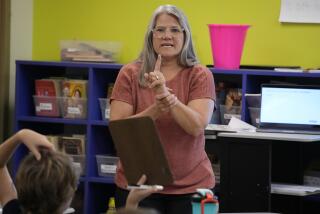Teaching Differences Do Add Up : Two Books Compare Math Education in U.S. With That in Asian Countries
- Share via
To improve student learning, you have to improve teaching. That’s pretty obvious. But until recently, that common-sense idea hadn’t commanded much attention from education reformers.
Congress is debating what it can do to help make that happen. Among the ideas are more tests of teachers, more classes in academic subjects, fewer classes in education and even a downplaying of licensing in favor of practical experience.
Two insightful and provocative books that compare teaching in America with teaching in Asian countries whose students far outperform our own do not offer any easy solutions. But they do show how far we must go to catch up.
Both are about teaching mathematics but offer lessons that go far beyond math. Both consider how teachers learn their craft. Both analyze what it would take to change, and finally, both conclude that improving teaching is not a matter of getting different, smarter people to work in classrooms.
The title of Liping Ma’s book, “Knowing and Teaching Elementary Mathematics: Teachers’ Understanding of Fundamental Mathematics in China and the United States” (Lawrence Erlbaum Associates, Mahwah, N.J.), will not make it a bestseller. But it tells an intriguing tale and is already a hit in math circles.
The reason, according to a foreword by Lee S. Shulman, who heads the Carnegie Foundation for the Advancement of Teaching, is that it states forcefully that teachers must know the subjects they teach.
But that is not enough, Ma says. They need to teach the “why” of math as well as the “how.” And they need to be able to explain important mathematical ideas, such as that multiplication (assembling small quantities to create larger ones) is the opposite of division (breaking big quantities into smaller ones).
Ma, now a consultant for Shulman’s organization, was a graduate student in Michigan when she became interested in comparing math teaching in the United States and in her native China. Researchers asked 23 accomplished American teachers to perform some basic calculations and then talk about how they would use them in a lesson.
The results were frightening. Asked to divide 1 3/4 by 1/2, only nine teachers got the correct answer of 3 1/2. They proceeded to talk about ways to use pizza or cookies to illustrate the problem. Only one made up a story that was accurate and helpful for students.
Ma went to China and gave 72 teachers there the same task. Every teacher got the right answer. Many said the problem could be done several ways, to illustrate different concepts. In addition, 90% of them were able to develop at least one story problem, and many suggested several.
The Chinese teachers were less educated, with only 10 to 12 years of formal schooling, including teacher training, compared with 16 to 18 years for American teachers. But Chinese elementary school teachers are not only more adept at the math they are expected to teach, they also know the concepts and the best ways to teach them.
Much of Chinese teachers’ expertise is learned on the job from master teachers. Most also have the luxury of specializing in math and one other subject even as elementary school teachers, whereas American elementary school teachers teach all subjects. Finally, the Chinese teachers spend far more time analyzing the textbooks, which focus on math, rather than on glitzy illustrations.
Another new book is based on an analysis of videotapes of eighth-grade teachers in the United States, Japan and Germany.
“The Teaching Gap” (The Free Press, New York) by James W. Stigler, a UCLA psychology professor, and James Hiebert, an education professor at the University of Delaware, argues that those tapes show that, within each nation, teaching is remarkably consistent.
U.S. teachers think of math as a set of inherently tedious skills. They “pump up students’ interest by increasing the pace of activities, by praising students . . . by the cuteness or real-lifeness of tasks, and by their own . . . enthusiasm, humor or ‘coolness.’ ”
But the American lessons lacked any mathematical proofs and generally consisted of “learning terms and practicing procedures” rather than concepts and ideas.
That contrasts most sharply with Japanese teachers, who treat math as a series of connected and interesting ideas that will in and of themselves motivate students to solve problems. They lead discussions, ask questions, present and critique students’ solutions, and weave together a lesson that has a beginning, middle and end.
The point, the authors argue, is that teaching methods are deeply ingrained in a culture. Teachers teach, in large measure, the way they were taught. Tinkering with the cultural “script” is not only ineffective but also could backfire.
More to Read
Sign up for Essential California
The most important California stories and recommendations in your inbox every morning.
You may occasionally receive promotional content from the Los Angeles Times.













